ABOVE: 1974 Norton Commando 850 Roadster.
BIRTH OF THE COMMANDO
While the Commando was a direct descendant of the the Norton Atlas & the Dominator line before that, the Commando was definitely not evolutionary. It was revolutionary, a true game-changer. Not because of some amazing new engine, not because it was all that faster than the model it replaced. It was because the new Norton Commando solved, in one brilliant design concept, the biggest problem that had been nagging every British motorcycle manufacturer for the past 20 years. Vibration!
ISOLASTIC SUSPENSION
The new Norton Commando came with a brand new frame, a whole new idea for a frame, one that isolated the engine & its vibration, from the rest of the bike via rubber mounts. It was called Isolastic Suspension & it immediately made the Norton Commando a runaway hit! Norton Motorcycles was now free to extract the kind of power the big twin was capable of without worrying about shaking the machine & rider to pieces!

1968 Norton Commando Fastback. Norton motorcycles became known for their loud & sometimes outlandish color schemes.
GOODBYE FEATHERBED
Mind you, it must have taken a lot for Norton to be willing to ditch the venerable, proven Featherbed Frame, the single most important piece of hardware Norton had ever produced & the one that put them on the map. The Featherbed was light, strong, rigid & above all, was renowned as the best handling frame on the planet. Why scrap it?
SOLVING THE VIBRATION PROBLEM
In the end, the very thing that gave the Featherbed its amazing handling, its rigidity, helped to do it in. So stiff a structure tends to transmit engine vibrations even more acutely & as displacement & output continued to climb, the vibration was really becoming a problem. Like Triumph & others, Norton fiddled with various tweaks to the engine internals (ie: compression ratios, flywheel weight, crankshaft balance factors, etc.), but nothing really seemed to work. When it started out life as a mildly-tuned 500cc twin, the vibration really wasn’t that noticeable. But as capacity grew to 600cc, 650cc, then 750cc, twin carbs sprouted, compression ratios climbed & revs increased, the vibration just got worse & worse. It was inevitable, considering those two pistons rising & falling together, flying back & forth thousands of times a minute. They didn’t want to detune the engine to tame it. If anything, they wanted more power. Norton needed to keep their bikes competitive with Triumph and BSA. What to do?

ABOVE: 1972 Norton 750 Commando Fastback. A front disk brake actually arrived partway through the 1972 model year. Some early ’72s still sported this fine TLS front drum, which utilized the same drum as the old SLS front brake from the Norton Atlas. Waste not, want not.
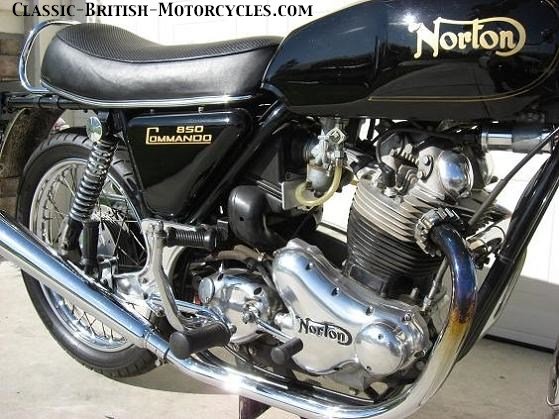
ABOVE: 1974 850 Norton Commando. Another innovation in the new Commando was the slanted cylinders. This was essentially the same engine as used in the Norton Atlas 750, but instead of being vertical like the Atlas, they tilted the Commando engine forward before mounting it, to give it a distinctive, more modern look. It worked.

NEW OWNERS
The Norton Commando was a direct result of the collapse of AMC (Associated Motor Cycles, Ltd) who owned Norton, Matchless & AJS, among others. AMC’s stable of brands was acquired by Manganese Bronze Holdings, who also owned Villiers, and the new company was renamed Norton-Villiers. And they had a plan.
AN ALL-NEW BIKE
The Matchless & AJS lines were struggling, but Norton showed great promise. Thanks to the Featherbed, the Norton Dominator & Norton Atlas had earned a reputation as fine-handling machines with good power. So, the decision was made to kill off the Matchless-AJS twins at the end of the 1966 model year & concentrating all resources on creating an entirely new motorcycle, an entirely new ‘type’ of motorcycle.
WORLD’S FIRST SUPERBIKE
The result was the 750 Norton Commando, the new type was that of Superbike. It was the first! The secret was the Isolastic Suspension. It freed engineers to extract all the power & revs out of the powerful twin. It was such a resounding success that it was named Motorcycle News’ “Motorcycle of the Year” 5 years running.
DIFFERENT MODELS
Norton Motorcycles spun 6 different models off the same basic machine. The Roadster (which was the basic Commando); The Interstate (designed as a long distance touring bike); The Fastback (with special seat & fender); The Hi-Rider (a hideous factory chopper); The Production Racer (a street-legal mildly-tuned GP bike); & The Interpol (the police version).
COMBAT FIASCO
Early Norton Commando MkI’s had frame bending problems that were solved with the introduction of a new, but very similar frame. In 1972 the 750 ‘Combat Engine’ was introduced as a raced-tuned engine that actually only produced 5hp more than the stock mill. But the Combat proved fragile, having been pumped up to its practical limits of performance, it was easily pushed too hard. Replacing blown Combat engines became the factories preoccupation for the latter part of 1972. The Combat was dropped for 1973.
SUCCESS!
The Commando was wildly successful, although Norton could never produce the volumes of bikes that Triumph did at the time. Demand outstripped supply, making them even more sought-after. The mystique continues today as Commandos are more popular than ever with collector & enthusiasts. Motorcycle Auctions bristle with various versions of the Norton Commando. They’re certainly fast enough & modern enough to keep up easily with todays’ traffic, making them an even better collectible. As with virtually all mass-produced Classic British Motorcycles, the Norton Commando is truly undervalued & underpriced in the marketplace. Buy one now before the world realizes that they can have an awesome machine like this for one third the price of a new Harley. But, with way more exclusivity.

ABOVE: 1974 John Player Norton, aka: JPN.
THE JOHN PLAYER CONNECTION
The Norton, always clever and resourceful, cut a sponsorship deal with John Player Cigarettes for their road racing efforts in the early 1970s. It was such a good idea that they homologated it into a street bike. Known as the JPN (short for John Player Norton), it was introduced to a stunned public in 1972, no one had every seen a street bike like this before. Today, fully faired road racers are quite common, but in 1972 they were unheard of. While looking the park of a full-on race machine, the street version of the JPN was actually mechanically stock in every way. JPN was basically an appearance package. Oh, but what an appearance! The look inspired legions of sport bike to follow, including another game-changing Honda 750 Interceptor in the early 80’s, a bike that even sported a similar color scheme. John Players are much sought-after today by collectors.
How Isolastic Suspension works
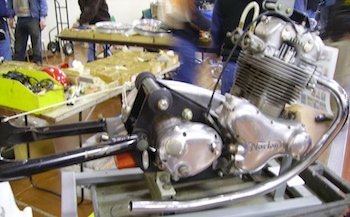
ROLLS ROYCE-SMOOTHNESS
The answer was the brainchild of former Rolls Royce engineer Dr. Stephan Bauer, who thought the Featherbed Frame was bunk. He took a whole new look at the situation. What he came up with was Isolastic Suspension. Essentially, the non-unit Engine/Primary/Gearbox is bolted together into a rigid unit via 2 steel mounting plates that also support the swing arm pivot & the rear rubber mount. There is a front rubber engine mount & a rubber-mounted headstay. In this way, the entire engine package & swingarm are connected to the frame in 3 places & isolated from it via the rubber mounts. The true genius of this system was not the rubber mounts, that had been tried before. Problems always arose keeping the chain aligned as the engine moved around in its soft mounts. Bauer solved this problem by mounting the swingarm pivot (& through it, the swing arm & rear wheel) to the engine so that they moved together as a unit, keeping chain tension & alignment constant. Another fringe benefit is that it gave the vibration a path to the ground & out of the bike. Rigidity was to be assured by a large-diameter 2.25″ backbone. However, the first frames on the 1968 Norton Commandos were actually prone to bending under stress. A new frame was introduced for the 1969 model year that solved the problem & this frame would serve throughout the rest of the Norton Commando’s short, but valiant life.
The new “Donington” Norton Commando

ABOVE: This 2014 Norton Commando 961 Sport shows the new face of Norton. Modern all the way, but instantly recognizable as a Commando.
THE REBIRTH OF THE NORTON COMMANDO
When the classic Commando went out of production in 1975, a battle over the rights to the name ensued. Ultimately UK business man Stuart Garner, who already owned Norton Racing Ltd acquired the rights to the Norton Commando brand. His new company, Norton Motorcycles Ltd, he commissioned Simon Skinner to design the new bike, and built a state-of-the-art factory in Donington Park, Leicestershire, England to produce them. It took until 2010 for the first production bikes to hit the market, at an initial rate of around 5 to 10 bikes per week. These, the first Norton Commandos in 30 years were available in three models: The 961 Sport, 961 Cafe Racer, and the 200-unit limited edition 961 SE.
Norton Commando YEAR-BY-YEAR
1968 COMMANDO
746cc OHV parallel twin
Commando Fastback
First year for world’s first Superbike! Isolastic suspension solves vibration. Norton Atlas is engine tilted forward. 8-inch TLS front brake & Roadholder forks.
1969 COMMANDO
746cc OHV parallel twin
Commando R Type
Commando S Type
Commando Fastback
Development continues on the Commando. New frame solves the bending problems. Sales are strong, performance awesome, and the look was all Norton!
1970 COMMANDO
746cc OHV parallel twin
Commando Roadster
Commando Fastback
Commando Type S
“Yellow Peril” Production Racer intros w/ front disk brake, long tank, cafe seat, half fairing & number plates!
1971 COMMANDO
746cc OHV parallel twin
Commando Roadster
Commando Fastback
Commando Type S
Norton introduces the bright “Yellow Peril”, a wild production race with front disk brake, long tank, cafe seat, half fairing, even number plates on the back!
1972 COMMANDO
746cc OHV parallel twin
Commando Roadster
Commando Fastback & LR
Commando Production Racer
Commando Hi Rider
Commando Interstate
Race-tuned “Combat” engine delivers 65hp at 6500rpm. Fast, but unreliable. New front disk brake.
1973 COMMANDO
746cc OHV parallel twin
828cc OHV parallel twin
Commando Roadster
Commando Fastback & LR
Commando Interstate
Commando Hi Rider
Commando Production Racer
Engine bored to 828cc (850), more torque, less stress.
1974 COMMANDO
828cc OHV parallel twin
Commando Roadster
Commando Interstate
Commando Hi-Rider
Norton John Player Special
Norton John Player Special
Norton introduces John Player Special, replica of red, white & blue racer.
1975 COMMANDO
828cc OHV parallel twin
Commando Roadster
Commando Interstate
Finally! Electric start. Along with it comes leftside-shifting. But alas, it’s Norton’s last full year of production, Norton slips into receivership.

1976 COMMANDO
828cc OHV parallel twin
Commando Roadster
Commando Interstate
Production for ’76 & ’77 combined is only around 1,200 bikes, assembled from the stockpile of parts & unfinished bikes that remained after the production line stopped.
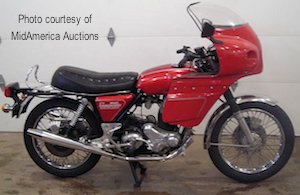
1977 COMMANDO
828cc OHV parallel twin
Commando Roadster
Commando Interstate
The last year of Norton production, with the last of around 1,200 bikes built in ’76 & ’77 roll out the door. Just 30 units are sold in ’78, leftovers from ’77. This is the end to yet another great English marque.
2014 COMMANDO 961
961cc OHV parallel twin w/EFI
Commando 961 Sport
Commando 961 Cafe Racer
Commando 961 SE (200 built)
Norton is back! As a totally modern bike that stays true to its roots. While still OHV, it now has a 3-bearing crank w/balance shaft & EFI.
Norton Commando MODEL-BY-MODEL
Norton’s ‘Street Scrambler’ (SS for short) had 2 high pipes running along the left side of the bike.
JOHN PLAYER NORTON
1974-1975
Norton’s factory cafe racer celebrating their racing successes with cigarette-maker John Player as a sponsor, only 200 were built.
NORTON COMMANDO PRODUCTION RACER
Norton’s hand-built race bike was made available to the public.
COMMANDO HI-RIDER
Norton’s wild factory chopper had high bars, a banana seat & sissy bar.
Check out these NORTON BOOKS
Norton Motorcycles: From 1950 to 1986 (British Motor cycles since 1950)
Norton Commando: The Complete Story (Crowood Motoclassic Series)
The Norton Commando Bible: All models 1968 to 1978
The Illustrated History of Norton Motorcycles (English and Spanish Edition)
Norton (Osprey Collector’s Library)
Norton Dominator Performance Portfolio 1949-1970
Norton: The Complete History (Crowood MotoClassics)
For more like this, please visit our
 |
PLEASE BUY MY NEW E-BOOK HERE Click here to buy now: |

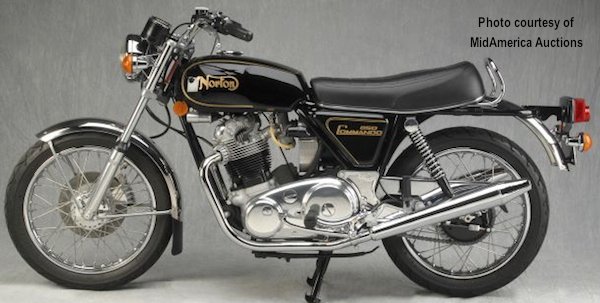











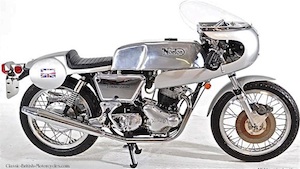













No Comment